As I wrote last week’s post about the adventures in Fredericksburg, Texas, I started the section about the country schoolhouses. And the words just kept coming. I either had to significantly shorten it or I needed to make country schoolhouses their own post. It can be hard to tell what readers enjoy but shortening posts often means taking out the story parts and leaving just the facts. I was a writer long before I was a blogger and I love story. It’s the individual details of a place that I remember and enjoy sharing the most. Facts just put the stories in context.
Besides, you can read the “facts” for yourself in the brochure or on the internet. What you cannot find in the brochure is what I experienced, saw and felt. So, I decided the Fredericksburg area country schools deserved their own post.
Plus, the post has an outhouse. How many blog posts can say that?
History of Country Schoolhouses
In the 1800s, as more and more people, specifically German immigrants, came to the area, the land they farmed was further from town. Country schoolhouses, mostly one-room, started popping up to educate the youngsters of the area. By the early 1900s, 44 schools were in operation around Fredericksburg.
In 1949, a law passed that consolidated many rural schools. Remarkably only two of the 44 rural schools were demolished. Some schools were adapted to private residences and others become community centers. In the 1950s, community clubs started to preserve the remaining rural schoolhouses even though they were owned by the school district. A rumor that the school district was going to sell the schools got everyone in an uproar and served to bring the individual clubs together to form Friends of Gillespie County Country Schools. It’s a great grassroots movement story.
Since then, 12 of the schools transferred back to Gillespie County and then leased back to the community clubs.
Country Schools Driving Trail
Visiting some of these schools is a fantastic option on a rainy day because most of the time is spent driving the back roads of Hill Country. The driving map I picked up at the Visitor’s Center suggested four different routes, each going in a different direction from Fredericksburg and each with three or four schools to visit.
Seventeen schools are on the driving map. Some of the extra schools are part of other entities (for example Junction School is at the LBJ National Historic Park and White Oak School is part of the Pioneer Museum). Two of the schools are in downtown Fredericksburg and one is by Lady Bird Johnson Municipal Park so they aren’t on any specific driving route.
I saw six of the schools and looked unsuccessfully for two others. The brochure estimates it would take 10 hours to do all the driving tours. Even without the trailer, driving isn’t something I love so I decided one route was enough for me. I chose route B.
It was an easy choice because once a month the Friends of Gillespie County Country Schools has an Open House. I had picked up the 2018 Open House schedule and their February date coincided with my time there. Each month between one and six of the schools are opened and staffed.
Cave Creek Schoolhouse and the Girls’ Outhouse
In February, only one school was open. But that’s okay, it was great information and fun. The school I visited was Cave Creek. It is a simple one-room building. Really not much to see. But the volunteers were welcoming, offered me cookies and coffee. I looked around the room a bit before one of the volunteers asked if I wanted a tour of the other buildings.
Of course, I did.
There was a teacherage (one small room where the teacher lived during the week before going home to her family on the weekends) attached to the pavilion where they would have year-end plays for the parents. And afterward, a big barbecue. The original stone barbecue pit was still on the property.
My tour guide got the biggest kick out of showing off the girls’ outhouse. I admit, I got a kick out of it too.
The boys and girls each had their own outhouses. Even though the outhouse had a door on it, the girls’ outhouse included a little privacy fence in front of it.
Apparently, the boys thought it was funny to sneak a peek in on the girls. My guide said the girls had no interest in spying on the boys because their outhouse was quite a bit farther from the schoolhouse and they didn’t want to walk down the hill.
My guide then asked if I knew what they used for toilet paper. I didn’t get to ponder the question before he answered, “The Montgomery Ward Wish Book,” he said.
I had to look up the wish book part. Of course, I knew of the Montgomery Ward catalog. It even has a place in my childhood memories, especially the Christmas catalog. I can remember playing a game with my sister where we each got to choose one item from every page. Some pages were easy while others took serious consideration.
Oh, a wish book. Got it. We wished we could have one item from every page. That was the popular name for the catalogue all the way back to the 1880s, only a few years after Aaron Montgomery Ward started his mail order business in 1872 so rural folks could get “city goods.”
Another gentleman, who was a local, caught up to us as we were stopped at the girls’ outhouse. My guide and the other man were both old enough that they grew up using outhouses. My guide laughed and said he remembered being so scared that spiders were going to crawl on him.
The other man said when he was a boy, he figured out a trick. Before he sat down, he would rip one of the pages from the Wish Book, roll it up tight and set a match to it. Then he’d take his torch and whirl it around inside the seat opening to sizzle or scare off any critters that might be lurking.
We agreed that this was ingenious.
The tour ended at the older model cars. What, you might wonder, does a line of old cars have to do with a Country School Open House. Well, nothing. It was just a way to attract visitors. Several locals bring their vintage vehicles to the Open House each month.
Then the two men started a conversation about one of the owners of one of the vehicles. Since it wasn’t a conversation I could participate in, I took photos of the cars, said my goodbyes and continued on my driving tour.
There were sprinkles on and off during my drive. But it was a great way to spend a few hours. You can do the driving trail anytime to see the outside of the schoolhouses. But it was well worth the effort to schedule it to coincide with an Open House day.
Notes on Two Other Country Schoolhouses
Junction School
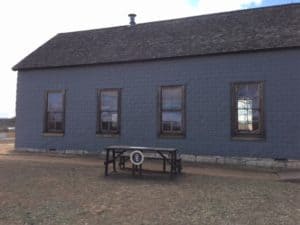
Outside the Junction Schoolhouse with a replica desk that LBJ and his former teacher sat at when he signed the landmark Elementary and Secondary Education Act of 1965.
When he was a small boy, President Johnson would spend a lot of time by the Pedernales River, a river that ran through the family’s property. His mother worried he would fall in and drown,. To keep him safe, she sent him to the county school at the age of four where he insisted on sitting on his teacher’s lap as she taught the class.
When he turned five, his family moved into Johnson City (named after his uncle), where he officially began his education.
He came back to Junction School on April 11, 1965, to sign the Primary and Secondary Education Act into law. His first school teacher sat next to him as he did so. He said, “Education is the passport from poverty.” He signed more education bills than any other president and is sometimes referred to as the Education President.
I never knew any of that. When I think of what I knew about LBJ, it was that he became president after President Kennedy was assassinated, his fight for civil rights and the conflict with the Vietnam War. I learned so much about the 36th President of the United Stated in my five weeks on his home turf.
White Oak School
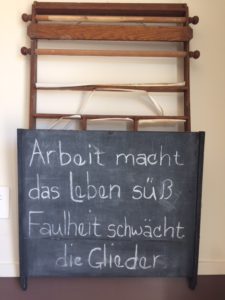
A German saying on a small blackboard in White Oak School. It says, Work makes life sweet. Laziness stiffens the joints.
Built in the 1920s, the Pioneer Museum bought the White Oak School in 1990. Last week, I shared my visit to the museum. I liked walking among the old desks, books and seeing all the lessons on the blackboard.
First graders cleaned the erasers. Did you ever do that or remember it? It’s clapping two erasers together to get the chalk dust out. It creates a chalk cloud and it’s terrible to breath. But someone had to get those erasers clean.
Last Thoughts on Fredericksburg
When in a new location, it’s easy and obvious to visit museums and the attractions that get most of the hype. Something like a driving tour or a country schoolhouse won’t be on the top things to do in the area. But don’t dismiss them outright. A lovely quiet experience is no less valuable just because it is a quiet experience.
I hope you enjoyed the 3-part series about Fredericksburg. Next stop: Middle Tennessee.
Links to Referenced SSL Blog Posts Above:


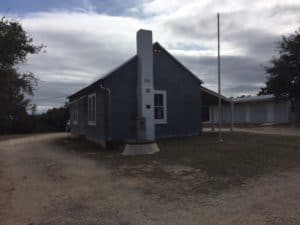
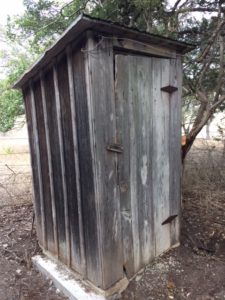
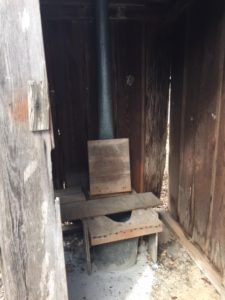
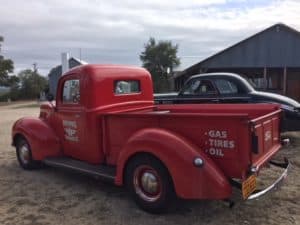
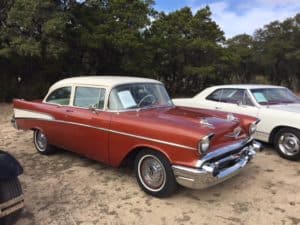
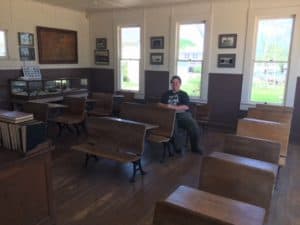



His and her outhouses, I never heard of that. At the Scandinavian House in Rapid City, they still use their outhouse as a public restroom. Be well. Love, Marie